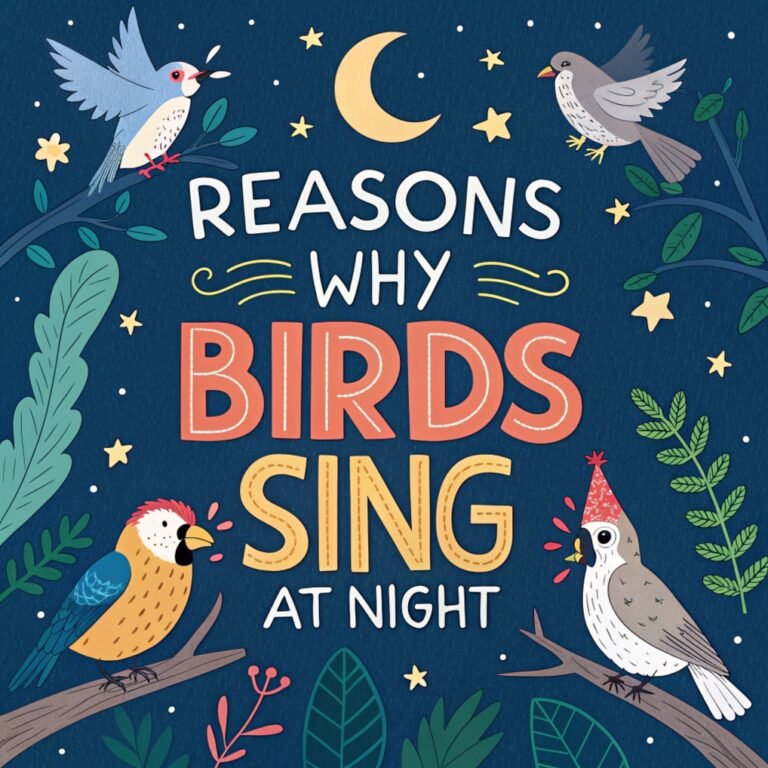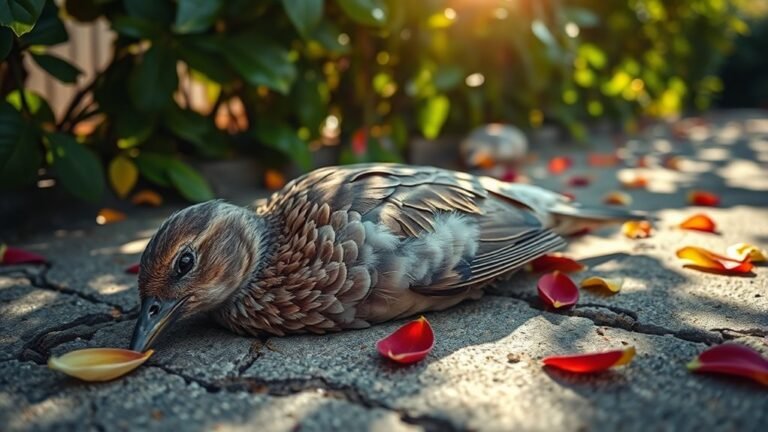Robin Birds: Their Meaning and Significance Explored
When you see a robin, you see more than a bird; you see a symbol in many cultures. Its bright colors signal the start of spring. Its song brings feelings of joy and change. Robins play an important role in nature, helping to maintain biodiversity. Think about what their presence means to you. Reflect on how these messages connect with your own experiences as we delve deeper.
Key Takeaways
- Robins symbolize renewal and new beginnings, marking the arrival of spring in various cultures and promoting a sense of hope and transformation.
- Their bright colors and songs indicate seasonal change, fostering appreciation for the environment and nurturing connections within nature's cycles.
- In dreams, robins represent personal renewal, encouraging self-love and reflection on emotional healing and relationships.
- Robins play a vital ecological role by controlling pests and promoting biodiversity through seed dispersal, reflecting overall environmental health.
- Their joyful presence encourages community interactions, resilience, and personal growth, highlighting themes of freedom and acceptance of life changes.
The Symbolism of the Robin in Different Cultures

The robin symbolizes renewal and new beginnings in various cultures. In many Western cultures, people see the robin as a sign of spring. It represents the return of life after winter. Its bright colors and cheerful song bring feelings of happiness and hope.
In some Indigenous traditions, robins represent transformation and the connection between all living things. Interpretations differ; for example, in European folklore, robins symbolize protection and guidance for lost souls.
These meanings highlight our desire to connect with nature's cycles, showing hope and the ongoing pattern of life. Overall, robins hold deep significance for people, enhancing our sense of belonging and connection to the world around us.
Robins as Symbols of Spring and Renewal
When spring arrives, robins become clear signs of seasonal change. Their vibrant red breasts and cheerful songs attract attention. These birds represent the freshness of spring and the renewal of life, signaling the end of winter and the start of new beginnings.
Robins migrate back as temperatures rise, returning to once-empty areas. Their songs create a lively atmosphere, encouraging other animals to wake up from their winter sleep.
In this way, robins symbolize hope, rebirth, and the cycle of life. Observing these delightful birds connects us to nature's seasonal changes, allowing us to appreciate its beauty and feel a sense of belonging in the world around us.
The Robin's Connection to Love and Relationships

Robins have a significant role in love and relationships. Their courtship displays symbolize the importance of building and nurturing love connections. Watching their commitment during mating seasons can inspire you to invest time and effort into your own relationships.
The robin's song represents communication, which is essential for emotional closeness. Additionally, robins form strong pair bonds, highlighting loyalty and trust in partnerships.
Spiritual Significance of Robins in Dreams
Dreams featuring robins hold important spiritual meanings. Robins often symbolize renewal and rebirth, highlighting personal transformation. Their bright red breast represents the heart and emotional healing. This suggests a need for self-love and nurturing relationships.
These dreams often carry messages about growth and new beginnings. They encourage you to embrace change and let go of things that no longer serve you. When you see robins in your dreams, reflect on your life and emotions.
They may guide you to reconnect with your true self or remind you of your relationships. Overall, dreaming of robins invites you to explore your spiritual journey and build a sense of belonging.
The Robin as a Messenger From the Spirit World

The robin is a special bird that many people view as a messenger from the spirit world. Its bright red breast and beautiful song catch attention easily. When someone sees a robin, it can mean they're receiving messages from lost loved ones. This bird helps connect people with those who've passed away, offering comfort during these moments.
People often feel a sense of peace or closeness to their loved ones when they spot a robin. Additionally, robins migrate with the seasons, reflecting the cycles of life and change. This behavior emphasizes the ongoing nature of life and the presence of those who are gone.
Thus, seeing a robin not only enhances your outdoor experience but also helps you feel the lasting bond with loved ones who've departed.
Folklore and Myths Surrounding Robins
Many cultures celebrate the robin for its bright colors and beautiful song. The folklore and myths about this bird add to its meaning. Different societies link robins to renewal and rebirth. They often connect robins with the arrival of spring.
In Native American stories, the robin symbolizes change and helps guide lost souls home.
In European folklore, people see the robin as a symbol of good luck or a protective spirit.
These stories show how the robin connects communities. They bring together ideas of hope, change, and emotional strength.
Knowing these tales deepens your relationship with nature. Embracing the themes of renewal and guidance in robin tales can inspire you and enrich your experiences outdoors.
Robins in Literature and Poetry
Writers often use the imagery of robins in their works to highlight themes of renewal, transformation, and hope. This bird has significant importance in many literary traditions.
Robin imagery acts as a strong poetic symbol, connecting readers to the cycles of nature. Authors create feelings of nostalgia and rejuvenation by using the robin as a symbol of spring and new beginnings.
The robin represents seasonal change and personal growth through adversity. This symbolism allows for deeper reflection on life's moments. Engaging with robin imagery helps readers feel connected to nature and the human experience.
The Role of Robins in Native American Traditions
Robins play an important role in many Native American cultures. They symbolize renewal and the changing of seasons. Their presence appears in Native stories, showing their deeper meanings related to fertility and rebirth.
Here are key points about robins:
- Spring Messenger: Robins signal the arrival of spring, connecting nature with human life.
- Fertility Symbol: Their nesting habits signify abundance and new beginnings.
- Cultural Stories: Many tales feature robins, teaching lessons about resilience and change.
- Healing Guides: The presence of robins offers spiritual guidance, fostering unity and balance in communities.
Robins are essential to understanding Native American traditions. Their vibrant colors and behaviors inspire hope and emphasize the cycle of life.
Robins and Their Association With Freedom
Robins symbolize renewal and freedom in various cultures. You can find these birds in many habitats, from open fields to woods, showing their adaptability.
Understanding robin behavior can enhance your connection to nature. Their cheerful songs and bright colors represent liberation and inspire individuals to pursue their own paths.
As you observe these birds, you'll see how they thrive and enjoy their journeys. This connection to freedom resonates with many, reminding you to cherish each moment in nature.
Every encounter offers a chance to embrace possibility, inviting a sense of belonging in your surroundings.
The Robin's Representation of Joy and Happiness
Joy appears with robins. Their bright colors and cheerful songs make the environment feel lively. This creates a sense of happiness and belonging.
Studies show that seeing and hearing robins can lead to positive feelings. Here are four reasons why robins represent joy:
- Bright Colors: Their reddish-orange breast catches the eye, reminding us of warmth.
- Cheerful Songs: Their songs provide a natural melody, helping us feel connected to others.
- Springtime Arrival: Robins signal the start of spring, a time of renewal and hope.
- Playful Interactions: Their social behavior shows a thriving community, encouraging our desire for connection.
Robins truly brighten our lives and uplift our spirits.
Robins as Symbols of Transformation
Robins appear in nature as symbols of change and renewal. These birds indicate personal transformations. When you see a robin, consider it a sign to accept your own changes.
Robins often show up as winter ends, marking a time of growth for the earth. This process can mirror your life, encouraging you to leave behind old ways and start fresh.
Robins can thrive in different places, showing their ability to adapt. This adaptability promotes resilience, motivating you to grow in response to life's challenges.
In this way, robins inspire you to begin your journey of self-discovery.
The Importance of Robins in Ecosystems
Robins are important for many ecosystems. They help keep nature balanced. Their nesting and breeding patterns support stable populations. Their territorial behavior shapes the dynamics of the prey they hunt.
Here are ways robins benefit the environment:
- Insect Control: Robins eat insects, which helps keep pest numbers low.
- Habitat Preferences: They live in different environments, showing us how healthy those areas are.
- Migration Patterns: When they migrate, robins spread nutrients across different regions.
- Biodiversity Support: By spreading seeds, they help various plants grow.
Recognizing these roles highlights how vital robins are in creating healthy ecosystems. They're key players in nature around us.
Personal Reflections and Experiences With Robins
Watching robins in your backyard can create a strong connection to nature. These moments often bring back happy childhood memories of springtime with family.
Seeing robins can change an ordinary day into a special experience, encouraging you to reflect on the seasons. You may value their presence and how they strengthen family bonds as stories about robins become shared memories.
These encounters promote appreciation for nature and stir deep emotions, reminding you of renewal and continuity in the natural world.
Frequently Asked Questions
What Habitats Do Robins Typically Prefer to Live In?
Robins prefer a variety of habitats. They thrive in both urban areas and forests. You can often see them nesting in backyards, parks, and wooded regions. They look for places that provide food and shelter. This adaptability helps them survive in different environments and makes them a common sight in many areas.
How Long Do Robins Usually Live in the Wild?
In the wild, robins usually live between 2 and 5 years. Some can live up to 10 years if conditions are good. Their lifespan depends on factors like the availability of food and the threat of predators. Understanding these factors helps us appreciate the challenges robins face in nature.
What Do Robins Eat?
Robins eat a variety of foods, mainly focusing on insects during their breeding season. Their diet includes worms, berries, and fruits. This variety helps them adapt to different seasons and ensures they remain healthy and energetic.
How Do Robins Build Their Nests?
Robins build nests in tree branches and shrubs. They collect materials like grass, twigs, and mud. This combination creates safe homes for their future chicks. The nest design provides warmth and a protective space for the eggs and young birds. Watching robins build their nests can be a delightful experience, showcasing their natural instincts and dedication to nurturing their young.
Are Robins Migratory Birds, and Where Do They Go?
Robins are migratory birds. They fly south in the fall and return north in the spring. This migration occurs due to changes in temperature and the availability of food. During migration, robins travel to find warmer climates and abundant food sources, making their journey essential for survival.

Hello, I’m Emily Price, the founder of Birds Affection. As a passionate bird enthusiast and spiritual seeker, I’ve always been fascinated by the symbolic meanings and mystical connections between birds and our lives. On this website, I share my knowledge and insights on the spiritual significance of various bird species, exploring their roles as messengers, guides, and teachers. Through my writing, I aim to inspire and educate others on the profound wisdom and beauty that birds bring to our world. Join me on this journey as we delve into the enchanting realm of bird symbolism and discover the hidden meanings behind these magnificent creatures.







